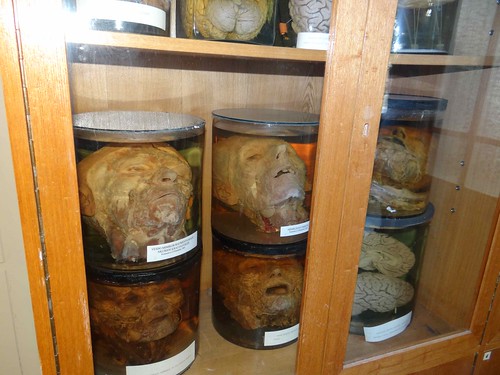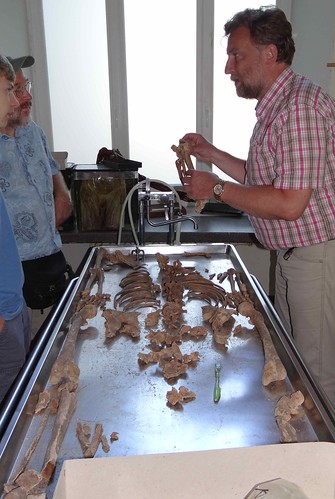I see Rimas coming and hurry towards him. Rimas is an interesting man, and I am glad to see that he has come to meet us. Yesterday while we were having dinner at his house in Lithuania, he invited us to come and have a look around his prosectorium (lab where he dissects bodies) in the Vilnius University. He had served us delicious soup that tasted sweet but a little tangy, and the taste is still lingering in my mouth even now, the next morning. I am excited because Rimas is more than an ordinary archaeologist; he is a forensic archaeologist! In other words, he can look at a human bone, and say how old the person was, how he died, and many other facts. I talk to him for a bit, and then he leads us inside to his prosectorium (A.K.A. lab).
As we walk into the hallway leading to his lab, I see the walls filled with shelves containing big glass jars. As I look into the big bottles, I recognize different human organs filled with dyes. Also, floating in the vile liquid, there are disembodied deformed heads, their noses twisted and their skin a sickly green. Their weeping eyes stare at me blankly. My nose wrinkles with the smell of vinegar.

When I walk into the prosectorium, I see tables with skeletons on them. In one part of the room, there is a college student working on a skeleton. She drops a bone, and I hear it hit another bone with a thud not unlike one of a wooden spoon hitting another. I walk over and talk to her for a while. She explains to me that her skeleton is from the seventeenth century. He had probably died from tuberculosis, a disease that dissolves your bones. Also, he had broken his shoulder a few times, and had carried a lot of weight.
On the other side of the room a photographer is taking pictures of fragments of a child’s skull. I find out from her that the child had been treated very roughly in his life. He had been shaken a lot, and you could tell from discolored spots on the inside of his skull where his brain had been sloshed around. Also, you could tell from “bruises” in the arm bones where he had been picked up and shaken. My mom walks over to her while I wander around.
I look around for a while longer, and I get to feel a skull from the middle ages. It is grainy, and feels exactly like what it looks like. It is yellowish and worn with age. I talk to Rimas a little about his biggest project, started a few years ago when a company was building a mall and found truckloads of human skeletons underneath. It had been his job to remove them safely from the construction site, and his job to find out who they were, when they were alive, and why the burials were concentrated so much on that exact site. He had found out that they were men from the army of Napoleon who had died exhaustion and cold in Vilnius when they were retreating from the Russians.


My mom has been talking to the photographer for a while, and finds out that the woman is an expert at hair. She usually works in Egypt on mummies. She could do some tests on your hair, and find out what you have been eating for as long as your hair has been growing. She could also tell if you were pregnant, male or female, and many other amazing things. All that information can be discovered from a mere scrap of hair. She says she feels it is her duty to tell the world the history of children. She feels the only history known is the history of the adults. This moves my mother.
As we drive back to our hotel in Vilnius, I stare out the window, looking into space. I see flashes of the different objects: the preserved head, the fragmented child skull, the prosectorium. It has been an awesome visit.
Lukas Bruihler is a member of the Youth Travel Blogging Mentorship Program
All photos courtesy and copyright Lukas Bruihler
